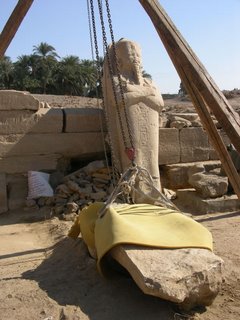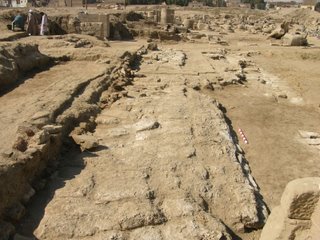 At the start of the week, finding the mud brick of the northern enclosure wall proved easier than we hoped, at least at the west end. Here there was only a relatively thin layer of earth over the bricks. It's dusty work.
At the start of the week, finding the mud brick of the northern enclosure wall proved easier than we hoped, at least at the west end. Here there was only a relatively thin layer of earth over the bricks. It's dusty work. Further to the east, the bricks were more deeply covered, but by week's end their pattern was clear. Abdel Aziz (in light blue galabiya) and Mahmoud Abbadi (dark blue galabiya), two of our Qufti, carefully define the bricks. The Qufti are technicians from the village of Quft, north of Luxor, who provide the skilled labor for many archaeological expeditions in Egypt.
Further to the east, the bricks were more deeply covered, but by week's end their pattern was clear. Abdel Aziz (in light blue galabiya) and Mahmoud Abbadi (dark blue galabiya), two of our Qufti, carefully define the bricks. The Qufti are technicians from the village of Quft, north of Luxor, who provide the skilled labor for many archaeological expeditions in Egypt. Looking east along the enclosure wall at the end of the week. We are fairly certain we have found the south face of the wall along the whole length of Temple A's Forecourt.
Looking east along the enclosure wall at the end of the week. We are fairly certain we have found the south face of the wall along the whole length of Temple A's Forecourt. Late in the week William and Elsie Peck, former curators at the Detroit Institute of Arts joined the team. William is our architect and surveyor and Elsie is site supervisor and artist. With Jaap van Dijk they admire a block from Chapel D that we reassembled recently from broken pieces. If we can figure out where it belongs in the chapel we'll restore it.
Late in the week William and Elsie Peck, former curators at the Detroit Institute of Arts joined the team. William is our architect and surveyor and Elsie is site supervisor and artist. With Jaap van Dijk they admire a block from Chapel D that we reassembled recently from broken pieces. If we can figure out where it belongs in the chapel we'll restore it. The siba (tripod and winch) arrived Wednesday morning and here is being set up by the East Porch so we can carry out the next phase of work there.
The siba (tripod and winch) arrived Wednesday morning and here is being set up by the East Porch so we can carry out the next phase of work there. Our conservator, Khaled, supervises rigging the portion of the wall between two columns that needs to be moved. It must be done with great care to protect both the workers and the block.
Our conservator, Khaled, supervises rigging the portion of the wall between two columns that needs to be moved. It must be done with great care to protect both the workers and the block. Success. Despite the close quarters, we are able to remove the top block of the intercolumnar wall without damaging it or the columns on either side. We were also able to remove the course below successfully.
Success. Despite the close quarters, we are able to remove the top block of the intercolumnar wall without damaging it or the columns on either side. We were also able to remove the course below successfully. For once we found Mary, the expedition's photographer, a comfortable position; usually she's up a ladder or flat on the ground. The wall in the last photograph has been completely dismantled and she is photographing its foundations. The limestone block just beyond her shoes has part of the name of Ramesses II, as do many of the foundation blocks in this area of the East Porch.
For once we found Mary, the expedition's photographer, a comfortable position; usually she's up a ladder or flat on the ground. The wall in the last photograph has been completely dismantled and she is photographing its foundations. The limestone block just beyond her shoes has part of the name of Ramesses II, as do many of the foundation blocks in this area of the East Porch. On January 14, President Mubarak visited Luxor. The streets along which he passed were lined with welcoming banners and arches.
On January 14, President Mubarak visited Luxor. The streets along which he passed were lined with welcoming banners and arches.One of the purposes of the President's visit was to open the Mubarak Heritage Center, a cultural center and library for Luxor. We didn't see the event itself (we were working that day), but were able to watch a group of children rehearsing for the event the day before. The Center itself is a large and dramatic building.


And now back to the dig. From this picture, taken late Thursday morning, you can get some idea of the scale of the work on the north enclosure wall. At the start of the week, all the workmen were standing on the top of the mound. They have made great progress. The time has come, however, to move the large fragment of a limestone statue leaning against the north side of the court, on the extreme right in this photo.
Supported by the siba and cushioned with foam sheeting, the statue is lowered slowly onto its side so it can be moved to its new location.
 The statue now lies on wood supports in front of Temple A's 2nd Pylon where we will re-erect it on Saturday beside its more complete companion.
The statue now lies on wood supports in front of Temple A's 2nd Pylon where we will re-erect it on Saturday beside its more complete companion.
 We haven't been idle on the south side of the Forecourt, either. The limestone foundations of the wall and colonnade are completely clear, as are the brick walls to the south (left). Now the challenge is to figure out how all these structures go together.
We haven't been idle on the south side of the Forecourt, either. The limestone foundations of the wall and colonnade are completely clear, as are the brick walls to the south (left). Now the challenge is to figure out how all these structures go together.
Egypt is a land where old and new constantly meet. Cement to build mastabas is delivered to the site on a donkey cart whose owner chats with a friend (or arranges his next delivery) on his cell phone. 
 Looking west along the sphinx avenue north of the Mut Precinct at noon to the village and the mountains beyond. What a view!
Looking west along the sphinx avenue north of the Mut Precinct at noon to the village and the mountains beyond. What a view!Richard Fazzini
Director







